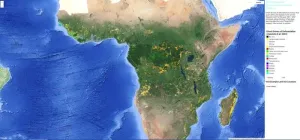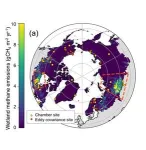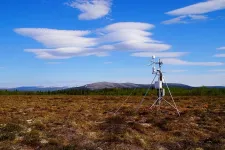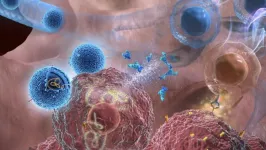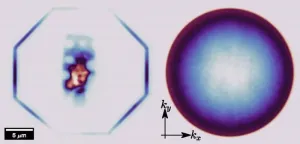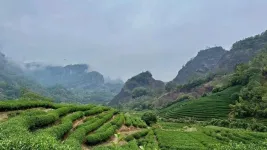(Press-News.org) Africa's forested areas – an estimated 14 % of the global forest area – are continuing to decline at an increasing rate – mostly because of human activities to convert forest land for economic purposes. As natural forests are important CO2 and biodiversity reservoirs, this development has a significant impact on climate change and effects the integrity of nature. To intervene in a targeted manner in the interests of climate protection and biodiversity, there has been a lack of sufficiently good data and detailed knowledge of the various forms of subsequent utilisation of deforested areas to track where forest-related conversions are happening and why. This has now been provided by a new study published in the journal Nature Scientific Reports and led by Robert N. Masolele and Johannes Reiche from Wageningen University in the Netherlands, Martin Herold from the GFZ German Research Centre for Geosciences in Potsdam, and their team. They used high-resolution satellite data, which they analysed on the basis of local reference data for 15 different types of land use – from crops such as coffee, cashew and rubber to pastureland and mining – with the help of deep learning methods. This enabled them to create the first high-resolution (accurate to five metres) and continental mapping of land use after deforestation across a wide area of the African continent, including wet and dry forests. This provides an improved basis for enhancing transparency on where commodity expansion leads to deforestation and for underpinning the strategic planning and implementation of deforestation mitigation measures by governments and forest protection agencies – both in Africa and in the EU, where a new EU-regulation aims to establish “deforestation-free supply chains” for products made from certain raw materials.
Background: Africa's threatened forests and the EU Deforestation Regulation
Over the last two decades, Africa has experienced a rapid decline in forest areas and tree cover. How land use develops after deforestation has a significant impact on forest biomass, biodiversity and the water cycle. These changes can vary depending on the location, intensity and spatial extent of forest loss. Understanding the spatio-temporal extent and motives of deforestation in Africa is critical to understanding and mitigating its contribution to greenhouse gas emissions and the negative impacts on the forest ecosystem.
The EU also wants to make an important contribution to curbing forest loss. The European Union’s Deforestation Regulation (EUDR) is a new initiative which aims to ensure that products placed on the EU market are deforestation-free and therefore protect the world's forests for future generations. It also promotes transparency and traceability in supply chains, making it easier for consumers to make informed choices about the products they purchase.
Insufficient database to date
Although there are some national and regional statistics documenting trends in forest loss, there is a lack of consistent, detailed and spatially explicit estimates and mapping of the factors responsible for forest loss. Available information is often only based on samples at individual points in time, is not available in sufficient spatial-temporal resolution and thematic classification and has so far only included dry forests. Interpretations are often based on visual inspection of satellite images and on the historical expectation that different forms of subsistence agriculture persist and that certain land uses are restricted to specific geographical locations. This overlooks the diversity of actual causes of forest loss.
Comprehensive approach to mapping with high-resolution satellite data and Deep Learning Methods
In a comprehensive study, researchers led by Robert N. Masolele, post-doctoral researcher at Wageningen University in the Netherlands, and Martin Herold, Head of Section 1.4 “Remote Sensing and Geoinformatics” at the GFZ German Research Centre for Geosciences and Professor at the University of Potsdam, have now deciphered the complex patterns of land use that emerge after deforestation in Africa's diverse landscapes. They present the first comprehensive map of land use after deforestation in Africa, covering forest loss from 2001 to 2020. The map is available with a spatial resolution of five metres and 15 land use classes: from crops such as cocoa, cashew, oil palm, rubber, coffee and tea to mining, roads, settlements, grazing land, small and large-scale agriculture as well as plantation forest and other land with tree cover.
On the one hand, the researchers relied on the high-resolution Planet NICFI satellite data provided by Norway's International Climate & Forests Initiative (NICFI). Accordingly, the study was conducted on the African continent between 30 degrees north latitude and 30 degrees south latitude and includes countries in western, central, eastern and southern Africa. The region is characterised by both humid and dry forests.
Secondly, they used reference data from various publications, some of which were obtained via crowd-sourcing with the help of citizen science or from other remote sensing campaigns and open data sources.
“What makes this study special is the innovative use of satellite imagery, machine learning algorithms and active learning. This allowed us to accurately identify post-deforestation land use, map it at an unprecedented scale and level of detail, and assess the trend and hotspots of land use conversion in different countries and regions of Africa,” explains Robert N. Masolele, lead author of the study.
The most important results
The study reveals a complex web of land uses that emerge after deforestation events. It shows that the causes of forest loss vary from region to region. In general, small-scale cropland is the main driver of forest loss in Africa, with hotspots in Madagascar and the Democratic Republic of Congo. In addition, commodity crops such as cocoa, oil palm and rubber are dominant drivers of forest loss in the humid forests of western and central Africa, forming an “arc of commodity expansion” in that region. At the same time, the hotspots for cashew are found to increasingly dominate in the dry forests of both western and south-eastern Africa, while larger hotspots for large-scale croplands were found in Nigeria and Zambia. The increased expansion of cacao, cashew, oil palm, rubber, and large-scale croplands observed in humid and dry forests of western and south-eastern Africa suggests they are vulnerable to future land-use changes by commodity crops.
Classification and outlook
Although the mapping is very extensive, the study recognises that it is difficult to classify certain forms of land use with a high degree of accuracy. Factors such as cloud cover and seasonal variations present limitations that emphasise the need for continuous refinement and validation.
“The study makes a crucial contribution to our understanding of the complex interplay between human economic activities and the environment. Its particular importance lies in the fact that it provides policy makers, conservationists and scientists with a detailed understanding of the different developments that land undergoes in large parts of Africa after deforestation. This knowledge is crucial for developing targeted conservation strategies, achieving the Sustainable Development Goals and mitigating the environmental impacts of deforestation across the African continent,” emphasises Martin Herold. “We in Europe will also benefit from this, as the new EU deforestation regulation requires proof of deforestation-free supply chains for certain raw materials such as coffee, cocoa and rubber.”
Overall, this new study showcases the great potential of using high-resolution satellite data, combined with artificial intelligence and regional knowledge to provide open-source information for different stakeholders and enhance the transparency for tracking critical forest-related land use transitions in tropical forests.
END
How is deforested land in Africa used?
With satellite data and machine learning methods, it is possible to identify and locate 15 forms of land use – from the cultivation of various crops to pastureland and mining
2024-02-15
ELSE PRESS RELEASES FROM THIS DATE:
Studies with more diverse teams of authors get more citations
2024-02-15
Diverse research is more impactful in the business management field, with female influence growing stronger in the past decade, finds a new study from the University of Surrey.
The study analysed all articles published in the last 10 years (January 2012 to December 2022) in the influential Journal of Management Studies.
The empirical analysis examined three key aspects of teams’ diversity:
Internationality (how international is mix of authors),
Interdisciplinarity (how many different fields of study they come from),
Gender ...
UC Irvine researcher co-authors ‘scientists’ warning’ on climate and technology
2024-02-15
Irvine, Calif., Feb. 15, 2024 – Throughout human history, technologies have been used to make peoples’ lives richer and more comfortable, but they have also contributed to a global crisis threatening Earth’s climate, ecosystems and even our own survival. Researchers at the University of California, Irvine, the University of Kansas and Oregon State University have suggested that industrial civilization’s best way forward may entail embracing further technological advancements but doing so with greater awareness of their potential drawbacks.
In a paper titled “Scientists’ Warning on Technology,” published recently in the Journal of Cleaner ...
Methane emissions from wetlands increase significantly over high latitudes
2024-02-15
– By Julie Bobyock
Wetlands are Earth’s largest natural source of methane, a potent greenhouse gas that is about 30 times more powerful than carbon dioxide at warming the atmosphere. A research team from the Department of Energy’s Lawrence Berkeley National Laboratory (Berkeley Lab) analyzed wetland methane emissions data across the entire Boreal-Arctic region and found that these emissions have increased approximately nine percent since 2002.
Livestock and fossil fuel production are well studied for their role in releasing tons of methane per year into the atmosphere. Although more uncertain, quantifying natural wetlands emissions is important to predicting climate ...
Study finds new inhalable therapy is a big step forward in lung cancer research
2024-02-15
Lung cancer is one of the most common cancers and has one of the lowest survival rates in the world. Cytokines, which are small signaling proteins, such as interleukin-12 (IL-12), have demonstrated considerable potential as robust tumor suppressors. However, their applications are limited due to a multitude of severe side effects.
In a paper published Jan. 11 by Nature Nanotechnology, Biomedical Engineering Professor Ke Cheng and his research group demonstrate that using nanobubbles, ...
Damon Runyon Cancer Research Foundation awards $3.2 million to innovative early-career scientists
2024-02-15
The Damon Runyon Cancer Research Foundation has announced eight recipients of the 2024 Damon Runyon-Rachleff Innovation Award, established to support “high-risk, high-reward” ideas with the potential to significantly impact the prevention, diagnosis, or treatment of cancer. Five extraordinary early-career researchers will receive initial grants of $400,000 over two years, and each will have the opportunity to receive two additional years of funding (for a potential total of $800,000). This year, this “Stage 2” continuation ...
Scientific report reveals livestock as the key factor in cheatgrass spread
2024-02-15
For Immediate Release
Contact: Erik Molvar, Western Watersheds Project, 307-399-7910
Roger Rosentreter, Bureau of Land Management, Botanist (Retired), 208-991-8815
Don Mansfield, Emeritus Professor of Biology, College of Idaho, 208-871-8170
Scientific Report Reveals Livestock Grazing as the Key Factor in Cheatgrass Spread
HAILEY, Ida. (February 15, 2024) – A scientific report released today illuminates the causes of cheatgrass spread and compares the effectiveness ...
NRL discovers two-dimensional waveguides
2024-02-15
WASHINGTON – The U.S. Naval Research Laboratory (NRL), in collaboration with Kansas State University, announce the discovery of slab waveguides based on the two-dimensional material hexagonal boron nitride. This milestone has been reported in the journal Advanced Materials.
Two-dimensional (2D) materials are a class of materials which can be reduced to the monolayer limit by mechanically peeling the layers apart. The weak interlayer attractions, or van der Waals attraction, allows the layers to be separated via the so-called ...
AIBS names 2024 emerging public policy leaders
2024-02-15
The American Institute of Biological Sciences (AIBS) is pleased to announce that Alex Rich and Efraín Rodríguez-Ocasio have been selected to receive the 2024 AIBS Emerging Public Policy Leadership Award (EPPLA). The award recognizes graduate students in the biological sciences who have demonstrated leadership skills and an aptitude for working at the intersection of science and public policy.
Alex Rich is a Ph.D. student in neuroscience at Yale University in New Haven, Connecticut. Her research focuses on decision-making and disordered ...
Shuffling the deck for privacy
2024-02-15
By integrating an ensemble of privacy-preserving algorithms, a KAUST research team has developed a machine-learning approach that addresses a significant challenge in medical research: How to use the power of artificial intelligence (AI) to accelerate discovery from genomic data while protecting the privacy of individuals.[1]
“Omics data usually contains a lot of private information, such as gene expression and cell composition, which could often be related to a person’s disease or health status,” says KAUST’s Xin Gao. “AI models trained on this data – particularly deep learning models – have the potential to retain private ...
Root microbes may be the secret to a better tasting cup of tea
2024-02-15
You’d think the complex flavor in a quality cup of tea would depend mainly on the tea varieties used to make it. But a study appearing in the journal Current Biology on February 15 shows that the making of a delicious cup of tea depends on another key ingredient: the collection of microbes found on tea roots. By altering that assemblage, the authors showed that they could make good-quality tea even better.
“Significant disparities in microbial communities, particularly nitrogen metabolism-related microorganisms, were identified in the roots of tea plants with varying qualities through ...
LAST 30 PRESS RELEASES:
Ticking time bomb: Some farmers report as many as 70 tick encounters over a 6-month period
Turning garden and crop waste into plastics
Scientists discover ‘platypus galaxies’ in the early universe
Seeing thyroid cancer in a new light: when AI meets label-free imaging in the operating room
Neutrophil-to-lymphocyte ratio may aid risk stratification in depressive disorder
2026 Seismological Society of America Annual Meeting
AI-powered ECG analysis offers promising path for early detection of chronic obstructive pulmonary disease, says Mount Sinai researchers
GIMM uncovers flaws in lab-grown heart cells and paves the way for improved treatments
Cracking the evolutionary code of sleep
Medications could help the aging brain cope with surgery, memory impairment
Back pain linked to worse sleep years later in men over 65, according to study
CDC urges ‘shared decision-making’ on some childhood vaccines; many unclear about what that means
New research finds that an ‘equal treatment’ approach to economic opportunity advertising can backfire
Researchers create shape-shifting, self-navigating microparticles
Science army mobilizes to map US soil microbiome
Researchers develop new tools to turn grain crops into biosensors
Do supervised consumption sites bring increased crime? Study suggests that’s a myth
New mass spec innovation could transform research
Maternal nativity, race, and ethnicity and infant mortality in the US
Migration-related trauma among asylum seekers exposed to the migrant protection protocols
Jupiter’s moon Europa has a seafloor that may be quiet and lifeless
SwRI upgrades nuclear magnetic resonance laboratory for pharmaceutical R&D
House sparrows in northern Norway can help us save other endangered animals
Crohn's & Colitis Foundation survey reveals more than 1/3 of young adults with IBD face step therapy insurance barriers
Tethered UAV autonomous knotting on environmental structures for transport
Decentralized social media platforms unlock authentic consumer feedback
American Pediatric Society announces Vanderbilt University School of Medicine as host institution for APS Howland Visiting Professor Program
Scientists discover first method to safely back up quantum information
A role for orange pigments in birds and human redheads
Pathways to net-zero greenhouse gas emissions for Southeast Asia
[Press-News.org] How is deforested land in Africa used?With satellite data and machine learning methods, it is possible to identify and locate 15 forms of land use – from the cultivation of various crops to pastureland and mining
